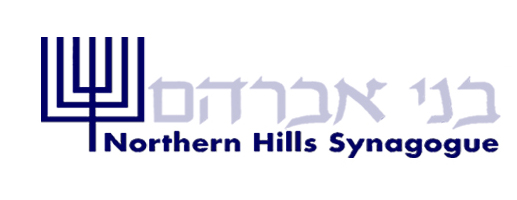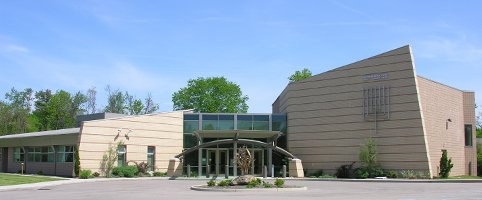A
Short History of
Northern Hills Synagogue
Northern Hills Synagogue - Congregation B'nai Avraham is the product of the migration ofJews to suburban areas and the entrance of many into technical and professional fields. Among those who settled, in the late 1950s, in the Springfield Township area known as Finneytown were Jews who had grown up in the older areas of Jewish settlement such as Avondale and Bond Hill. They were joined by Jews from other cities who had come to Cincinnati to work for major industrial firms such as Procter and Gamble and General Electric. These people formed the Northern Hills Jewish Couples Club, which became the Northern Hills Jewish Community. Seeking a more organized Jewish lifestyle for their families, this group became Northern Hills Synagogue - Congregation Beth El, which held its first Shabbat service on July 8, 1960, under the leadership of Rabbi Bertram Mond.
It took some time for the congregation to establish roots and an identity of its own. Although Rabbi Mond's training was Orthodox, the congregation sought to embrace Jews of all persuasions. However, the members felt a need for a stronger identity, and in 1963 the congregation voted to affiliate with the United Synagogue of America (now the United Synagogue of Conservative Judaism), and adopt the practices of the Conservative movement. At first, the congregation occupied rented quarters, moving several times. But by 1964, the congregation was sufficiently established to construct Its own building, called the Zuckman Center, at 715 Fleming Road.
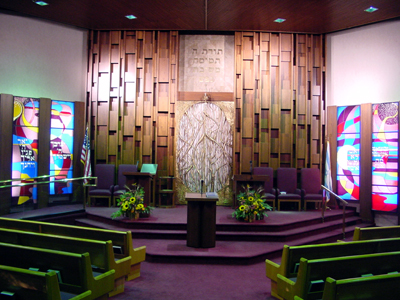
The
Roth Sanctuary at Fleming Road
|
In 1967, the struggling young congregation received an infusion of strength and experience through merger with the Norwood Congregation - Congregation B'nai Avraham. The Norwood Congregation had been chartered in 1914, and, after flourishing for several decades, went into decline as Jews moved away from that community. Most of the members of the Norwood Congregation became life members of the resulting Northern Hills Synagogue - Congregation B'nai Avraham, and Northern Hills Synagogue also received the assets of the Norwood Synagogue, including several sifre torah and a cemetery in Covedale.
In 1969, Rabbi Mond left Cincinnati because of his wife's serious illness, and Rabbi Henry Barneis was chosen as spiritual leader. He served until 1972, when he retired and moved to Israel. Rabbi Ephraim Rubinger served as rabbi from 1972 through 1975. He was succeeded in 1975 by Rabbi Gershom Barnard, who is now the longest-serving Rabbi in the greater Cincinnati area.
As the congregation grew during this period, an expanded facility was needed. To meet this need, the Litz Auditorium was added in 1973, providing the congregation with a multi-purpose room used as the congregation's main sanctuary and social hall.
Throughout the 1970s and early 1980s, the congregation, like other Conservative synagogues, struggled with issues pertaining to the participation of women. In 1984, after several years of compromise measures, the congregation's religious services became completely egalitarian. Although fear of "splitting the congregation" had played a role in delaying that decision, once the decision was made, the overwhelming majority of congregants approved of it.
In 1987, changes in Jewish residence patterns again made their mark on the congregation, as it absorbed Havurat Tzedek, a group who had been conducting services at Yavneh Day School (now Rockwern Academy) in Cincinnati’s northeast suburbs. To meet these needs, for a number of years Northern Hills maintained a Northeastern Branch, which conducted services twice a month at Yavneh. Over time, the new members who joined through the havurah and the Northeastern Branch became fully integrated into congregational life, and many became leaders of the congregation. As the 1980’s concluded, the Fleming Road facility was again expanded, with the 1988 addition of the Goldstein Building to the front of the building, which included the Roth Sanctuary and Neusner Lobby.
From the beginning, the religious education of its children was a congregational priority. From 1960 through 1993, the congregation relied on the Cincinnati Community Hebrew Schools for that purpose, and a branch of CCHS was located in the synagogue building. However, by the early 1990’s, as community priorities changed, the need for the congregation to establish its own religious school was clear. On July 1, 1992, Northern Hills Synagogue Religious School opened its doors. The first Educational Director, Sheryl Gross, had been the last Educational Director of CCHS, which maintained continuity with the CCHS program. At the same time, efforts were made to strengthen the connection between the religious school and the congregation, and with an emphasis on family education. In 1995, Haviva Horvitz became the Director of Education and Programming. She was succeeded in 2000 by Rebecca Starr, who was followed by Tracy Weisberger and then by Maksim Shilkrot in 2012.
In 2009, Northern Hills operated a joint religious school with Congregation Ohav Shalom, forming the Kehilla School for Creative Jewish Education. In 2015, the partnership was dissolved and NHS created the new Spark School with Director of Education Brian Freedman.
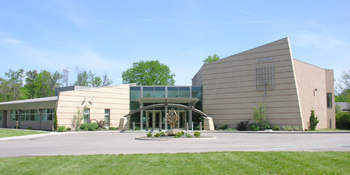 In addition, the congregation has long recognized the importance of the informal Jewish education provided by youth groups. A youth group was established in the congregation's early years. During the early 1970s, the youth group affiliated with Young Judaea, but that organization, sponsored by Hadassah, was not oriented toward synagogue-based organizations. In 1979, the synagogue's youth groups affiliated with Kadima and United Synagogue Youth, sponsored by the United Synagogue. For the past several years, our youth groups have been combined with those of Congregation Ohav Shalom. We are very proud of the awards our youth groups have won. In addition, the congregation has long recognized the importance of the informal Jewish education provided by youth groups. A youth group was established in the congregation's early years. During the early 1970s, the youth group affiliated with Young Judaea, but that organization, sponsored by Hadassah, was not oriented toward synagogue-based organizations. In 1979, the synagogue's youth groups affiliated with Kadima and United Synagogue Youth, sponsored by the United Synagogue. For the past several years, our youth groups have been combined with those of Congregation Ohav Shalom. We are very proud of the awards our youth groups have won.
As the 1990’s moved forward, it became increasingly clear that the members of the congregation were concentrating in Cincinnati’s northeast suburbs, as were other members of the Jewish community.
After thorough study and much discussion, in October 1999 the congregation voted overwhelmingly to relocate to the northeast suburbs. In December 2000, the congregation purchased 5 acres of land at 5714 Fields Ertel Road in Deerfield Township, Warren County. The congregation engaged Architectural Group International to design the new facility. Many committees with many volunteers went to work envisioning and refining the plans for the new building.
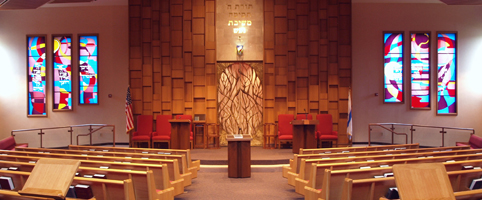
The Roth Sanctuary
|
The congregation moved into its new facility on Fields Ertel Road on March 19, 2004. The new sanctuary retains many elements from the old building, including the Ark doors and stained glass windows.
Of special meaning to the congregation is the "Burning Bush" sculpture. It was installed in September 2006 in front of the synagogue’s entrance and is dedicated in memory of Norm Weiser, one of our founding members and a voice of wisdom in congregational life.
It was designed by member Julie Staller-Pentelnik and sculpted by David Klass. A unique design feature is that the "flame" is the Hebrew letter "shin," which can be seen from almost any angle.
Northern Hills Synagogue prides itself on the sense of community it fosters and its ongoing efforts to meet the needs of its members and the larger community. Beginning in 1999, NHS has been recognized by the United Synagogue of Conservative Judaism, in the form of 23 Solomon Schechter Awards for Excellence in Synagogue Programming, in categories including Membership, Education, Israel Affairs, Celebrations, and Performing Arts, among others.
In 2011, NHS received a Bronze Schechter Award in "Celebrations & Dedications" Category for its 50th Anniversary Jubilee Gala. In January of 2010, Northern Hills Synagogue celebrated its 50th anniversary with a variety of activities. These included a Scholar in Residence weekend featuring Rabbi Brad Artson and a celebratory Gala. It was a time for reflection and contemplation, and a time to look forward with excitement to the challenges of the future.
As 2014 dawned, Northern Hills Synagogue began preparing for Rabbi Barnard’s retirement. As part of the celebration, in February the congregation welcomed noted author Rabbi Naomi Levy as Scholar in Residence. The festivities culminated with a Gala Tribute to Rabbi Barnard in May. Rabbi Barnard retired in June, after 39 years of dedicated service, and will remain part of the Northern Hills community as Rabbi Emeritus.
Rabbi Noah Ferro is the new Spiritual Leader at Northern Hills Synagogue. He began full-time status as of July 1, 2018.
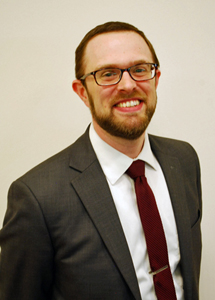
|
|
|
